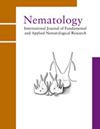在中国马尾松中发现的竹南拟蚜(Pseudaphelenchus chunanensis n.sp.)
IF 1.2
4区 生物学
Q2 ZOOLOGY
引用次数: 0
摘要
中国东部马尾松(Pinus massoniana)分支中分离到春南假螺旋体(Pseudaphelenchus chunanensis n.sp .)。该新种的特征是雄性(402 (360-452)μm)和雌性(470 (397-540)μm)非常短,外侧野有3个切口,花柱细长,基部有小而明显的节,排泄孔位于后脑前缘或更前缘。雄针状成对,刺状,离生,髁截形,有时宽圆形,喙圆锥形或三角形具钝尖尖端,盔状突起平滑渐细与板一起,薄和强弓形在中间然后渐细向钝尖的远端尖端,无穗状突。一个长而窄的囊围绕着整个尾巴,但在大多数雄性中不明显。圆锥形尾部直言圆形,但有时有短短毛。圆锥形的雌尾,平滑变细和在尾部的远端稍腹侧弯曲,末端细或钝尖。在类型学上与已知的6种假螺旋体线虫不同,基于部分18S核糖体DNA (rDNA)、内部转录间隔段(ITS)和28S rDNA序列D2-D3区域的详细系统发育分析进一步证实了该线虫为新种。本文章由计算机程序翻译,如有差异,请以英文原文为准。
Pseudaphelenchus chunanensis n. sp. (Tylenchina: Aphelenchoididae) found in Pinus massoniana from China
Pseudaphelenchus chunanensis n. sp. was isolated in branches of Pinus massoniana from eastern China. The new species is characterised by very short males (402 (360-452) μm) and females (470 (397-540) μm), three incisures in the lateral field, slender stylet with small but conspicuous basal knobs, excretory pore located at the level of anterior margin of the metacorpus or more anterior. Male spicules paired, thorn-like, separate, condylus truncate, sometimes broadly rounded, rostrum conical or triangular with bluntly pointed tip, calomus smoothly tapering together with lamina, thin and strongly arcuate in middle then tapering towards bluntly pointed distal tip, cucullus absent. A long and narrow bursa surrounds the entire tail but inconspicuous in most males. Conical tail bluntly rounded but sometimes has a short mucron. Female tail conical, smoothly tapering and slightly ventrally bent in distal part of tail, terminus fine or bluntly pointed. It is typologically different from six known Pseudaphelenchus species, and detailed phylogenetic analysis based on partial 18S ribosomal DNA (rDNA), internal transcribed spacer (ITS) and the D2-D3 region of 28S rDNA sequences further confirm this nematode as a new species.
求助全文
通过发布文献求助,成功后即可免费获取论文全文。
去求助
来源期刊

Nematology
生物-动物学
CiteScore
2.60
自引率
33.30%
发文量
67
审稿时长
3 months
期刊介绍:
Nematology is an international journal for the publication of all aspects of nematological research (with the exception of vertebrate parasitology), from molecular biology to field studies. Papers on nematode parasites of arthropods, and on soil free-living nematodes, and on interactions of these and other organisms, are particularly welcome. Research on fresh water and marine nematodes is also considered when the observations are of more general interest.
Nematology publishes full research papers, short communications, Forum articles (which permit an author to express a view on current or fundamental subjects), perspectives on nematology, and reviews of books and other media.
 求助内容:
求助内容: 应助结果提醒方式:
应助结果提醒方式:


